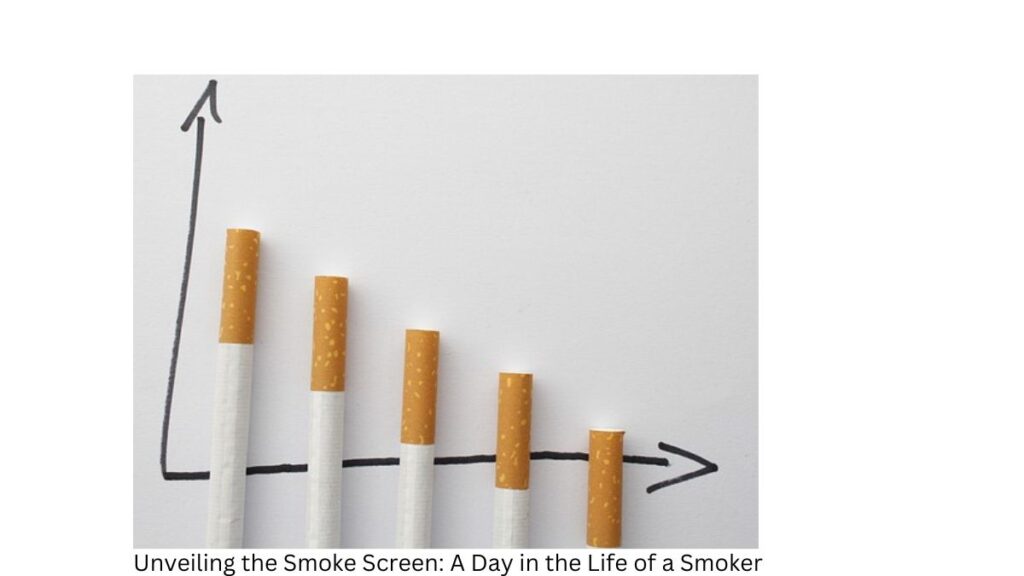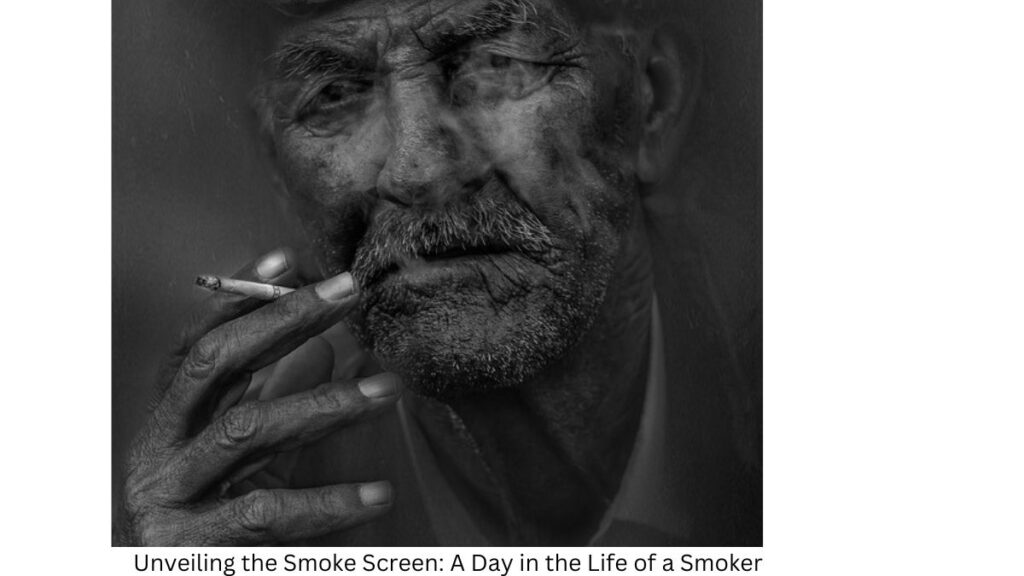Introduction:-
Unveiling the Smoke Screen: A Day in the Life of a Smoker

In the hustle and bustle of our daily lives, it’s not uncommon to encounter individuals who rely on cigarettes to navigate through their routines. In this blog post, we aim to demystify the daily rituals of a smoker, shedding light on the nuances that surround this habit. Join us as we delve into “A Day in the Life of a Smoker” to better understand the intricacies and challenges faced by those who choose to light up.
What are the intricacies and challenges faced by individuals who choose to light up in ‘A Day in the Life of a Smoker’?
Understanding the Morning Ritual: For many smokers, the day begins with a familiar routine – reaching for that first cigarette. Whether it’s the kick start to the day or a moment of solace, the act of lighting up becomes a ritual intertwined with waking up. In this section, we’ll explore the psychological and physical aspects that make the morning smoke an integral part of a smoker’s day.

The Workday Escape: As the day progresses, smokers often find themselves stepping outside for a break, seeking relief in the form of nicotine. Whether it’s a coping mechanism for stress or a social activity with colleagues, these breaks offer a glimpse into the daily challenges faced by smokers in professional settings. We’ll discuss the impact of smoking breaks on productivity and workplace dynamics.
Afternoon Reflections: The afternoon brings with it a mix of emotions and stressors. Some smokers turn to cigarettes as a way to cope with midday pressures, while others use this time for introspection. We’ll explore how the act of smoking serves as a brief escape from the demands of daily life and examine the potential consequences on mental health.
Evening Unwinding: As the day winds down, smokers may use cigarettes to mark the transition from work to leisure. The evening smoke becomes a moment of reflection and relaxation for many. We’ll analyze the role of smoking in the unwinding process and discuss alternative methods for stress relief that could potentially replace this habit.
Navigating Social Settings: Social interactions often play a significant role in a smoker’s day. Whether it’s bonding with friends over a smoke or using cigarettes as a conversation starter, we’ll explore the social dynamics associated with smoking and the challenges smokers may face in social situations.
What happens if I smoke 1 cigarette a day?
Smoking even just one cigarette a day can have detrimental effects on your health. While it might seem like a relatively small amount, the risks associated with smoking are cumulative, and any amount of smoking can increase the likelihood of various health issues. Here are some potential consequences of smoking just one cigarette a day:

- Health Risks:
- Respiratory Issues: Smoking damages the lungs and can lead to chronic respiratory conditions such as chronic bronchitis and emphysema.
- Cardiovascular Disease: Smoking increases the risk of heart disease, including coronary artery disease and stroke.
- Cancer: Even minimal smoking is associated with an elevated risk of developing various cancers, particularly lung cancer.
- Nicotine Addiction:
- Smoking even a small amount can lead to nicotine addiction. Nicotine is a highly addictive substance, and smoking, even infrequently, can create dependency.
- Financial Costs:
- Smoking comes with financial implications. Even one cigarette a day can add up in terms of the cost of cigarettes over time.
- Secondhand Smoke Exposure:
- If you smoke, you not only put yourself at risk but also expose those around you to secondhand smoke. Secondhand smoke is known to cause various health issues in nonsmokers, including respiratory problems and an increased risk of heart disease.
- Reduced Exercise Tolerance:
- Smoking can reduce lung function, impacting your ability to engage in physical activities. This can result in decreased exercise tolerance and overall fitness.
- Aging of the Skin:
- Smoking accelerates the aging process of the skin, leading to premature wrinkles and a dull complexion.
- Impact on Mental Health:
- Smoking has been linked to mental health issues, including an increased risk of depression and anxiety.
It’s important to note that the risks associated with smoking are dose-dependent, meaning the more you smoke, the higher the risks. Even light or occasional smoking is not without health consequences. If you are considering quitting smoking or need support, reaching out to healthcare professionals, smoking cessation programs, or support groups can be valuable resources. Quitting smoking, regardless of the amount, can have significant health benefits.
How can I quit smoking cigarettes?
Quitting smoking is a challenging but highly rewarding journey for your health. Here are some steps and strategies to help you quit smoking:

- Set a Quit Date:
- Choose a specific date to quit smoking. This can give you time to prepare mentally and make a commitment to the process.
- Seek Support:
- Inform your friends, family, and coworkers about your decision to quit. Having a support system can provide encouragement and accountability.
- Consider Nicotine Replacement Therapy (NRT):
- NRT, such as nicotine patches, gum, lozenges, or inhalers, can help manage withdrawal symptoms. Consult with a healthcare professional to determine the most suitable option for you.
- Prescription Medications:
- There are prescription medications, such as bupropion (Zyban) and varenicline (Chantix), that can aid in smoking cessation. Discuss these options with your healthcare provider.
- Behavioral Therapy:
- Consider behavioral therapy, either individually or in a group setting. Cognitive-behavioral therapy (CBT) and other counseling approaches can be effective in addressing the psychological aspects of smoking.
- Identify Triggers:
- Recognize situations, emotions, or activities that trigger the urge to smoke. Develop strategies to cope with these triggers without relying on cigarettes.
- Healthy Alternatives:
- Replace smoking with healthier habits. Exercise, meditation, deep breathing, or chewing gum can help distract you from cravings and reduce stress.
- Create a Smoke-Free Environment:
- Remove cigarettes, lighters, and ashtrays from your home and car. Make your living spaces smoke-free to minimize temptations.
- Celebrate Milestones:
- Celebrate your progress. Set short-term goals and reward yourself when you achieve them. This can provide positive reinforcement for your efforts.
- Stay Active:
- Regular physical activity can help reduce cravings and manage stress. Find activities you enjoy to keep yourself engaged and motivated.
- Plan for Challenges:
- Anticipate challenges and develop coping strategies. Know that withdrawal symptoms will lessen over time, and cravings will become less frequent.
- Stay Positive:
- Focus on the benefits of quitting, such as improved health, increased energy, and financial savings. Stay positive and remind yourself of your reasons for quitting.
Remember, quitting smoking is a process that may involve setbacks. If you slip up, don’t get discouraged. Learn from the experience and recommit to quitting. If you find it challenging to quit on your own, consider seeking professional help from a healthcare provider or a smoking cessation program. They can provide personalized guidance and support tailored to your needs.
Conclusion:
“A Day in the Life of a Smoker” unravels the layers of a habit that has persisted for generations. By understanding the daily rituals of smokers, we hope to foster empathy and encourage open conversations about alternatives and support systems. As society continues to evolve, acknowledging the complexities surrounding smoking is a crucial step towards promoting healthier choices and lifestyles.





